I have an ongoing interest in the early history of Meyer & Studeli, an interest which runs in cycles where I will check for new information becoming available where I actively seek out early watches. There are several areas where I continue to seek out information but without any great deal of success. One are is wondering what happened to all of the early brands that M&ST registered and presumably sold, yet so far I have yet to locate any examples. To be fair the early names are not ones which are easy to search.
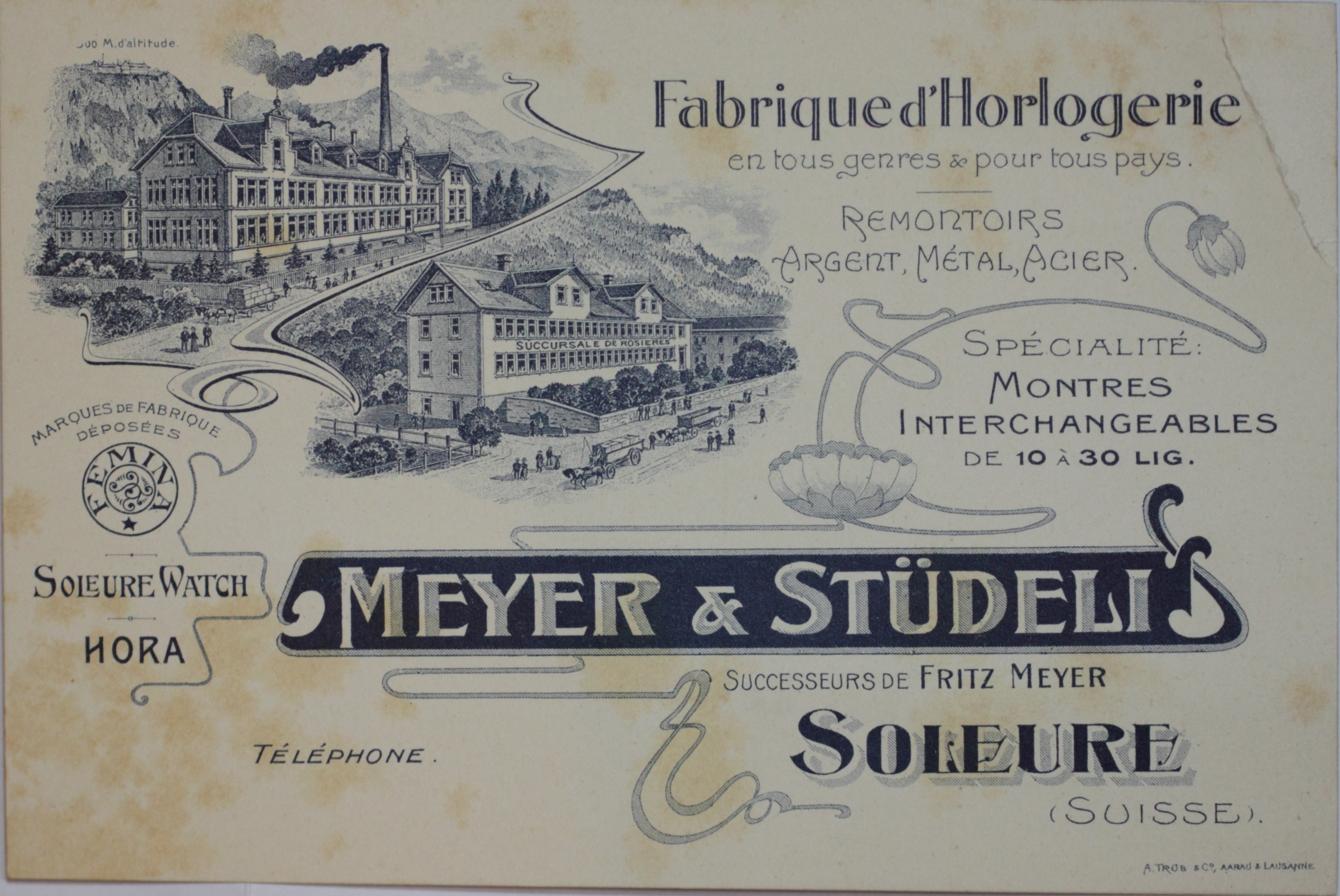
The card above includes mention of Femina (registerd 1900), Soleure Watch (1901) and Hora (1902), yet does not include Medana (1909). Registration dates thanks to the research of Andreas of Mikrolisk.de. The card probably dates to around 1907. Note too the horses and carts – not yet the motor cars featured on later pictures and subtly associated with the factory.
Then too there is the mystery of L Tieche Gammeter, the company that M&ST took over around 1917. LTG first appear in 1903 registering brand names. In 1908 they took part in some joint advertising with M&ST and some other Soleure companies which indicates that there was some degree of familiarity between them.
The two areas of outstanding mystery collide around the Roamer trademark first registered by LTG in 1909 and which later went on to be used by M&ST so successfully that it became the company name. We know that with wristwatches the earliest Roamers we have found date to 1918.
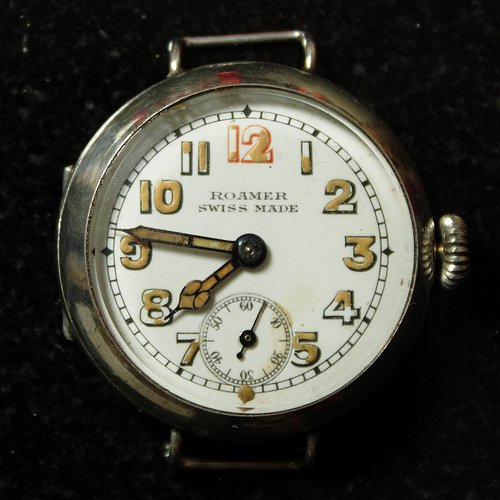
Yet that is nine years after the name was registered and puts that watch firmly in the period when ownership had passed to M&ST. One of my other avenues of research is in speculatively buying watches that might have been made by M&ST or LTG. Many of these turn out to be false trails but even so they have expanded my apreciation of just how interlinked the watchmaking companies were at that time. Some of that is likely because they bought ebauches from the same sources, some of that appears to be from selling calibre designs to each other, all of which can make it hard to be sure exactly who made what.
One of those speculative purchases was this watch which is marked LTG both on the case and calibre.
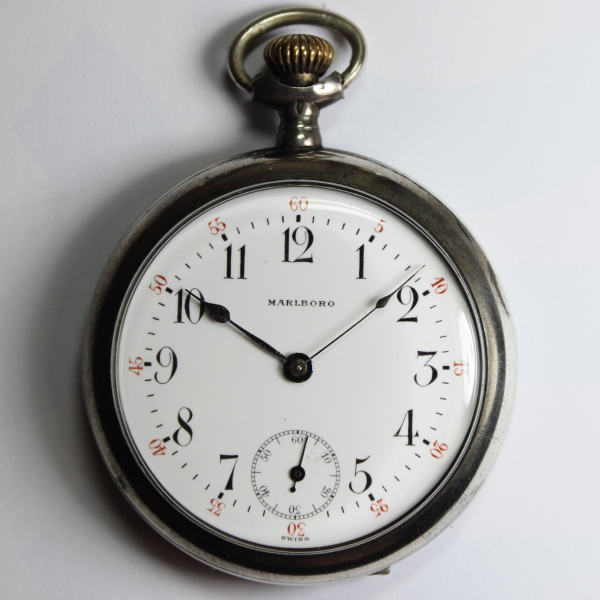
One of the interesting features was that it contained a calibre that was new to me. Bear in mind that the earlies list of calibres we have dates from 1933, which is easily one or two full calibre generations on from the first world war calibres. Indeed the 1918 wristwatch above is not included in the 1933 catalogue (though a bridge variation is). Finding a new calibre is rarely conclusive given that few are marked, but this case seemed reasonably sure since it is marked and I also found another that had a Roamer dial.
Recently I bought a job lot of broken pocket watches because it included a Roamer pocket watch that appeared to have a reasonable condition dial that I thought might be of use somewhere down the road. I was pleased to find that it was yet another example of this same calibre.
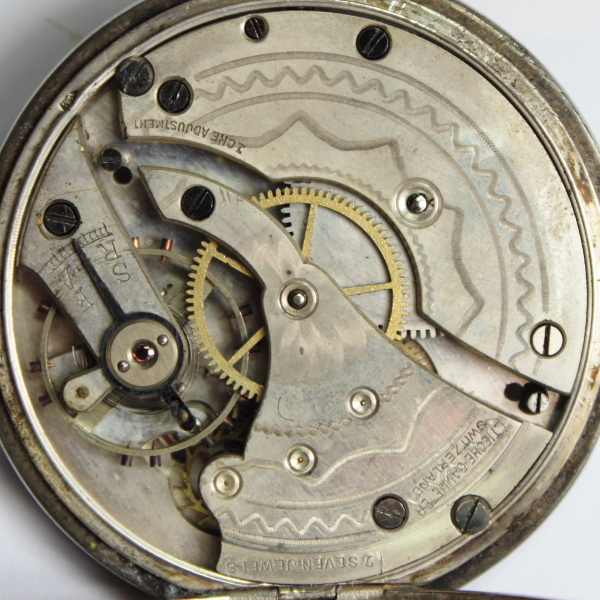
This calibre is interesting because removing the dial reveals that it has a rocker design for the keyless works – a relatively primitive and cheap design. More interesting because LTG patented a keyless works design in 1913 that is often found on their watches. Of course these calibres all seem to be 7 jewel so it might be an entry level calibre with a cheaper keyless works.
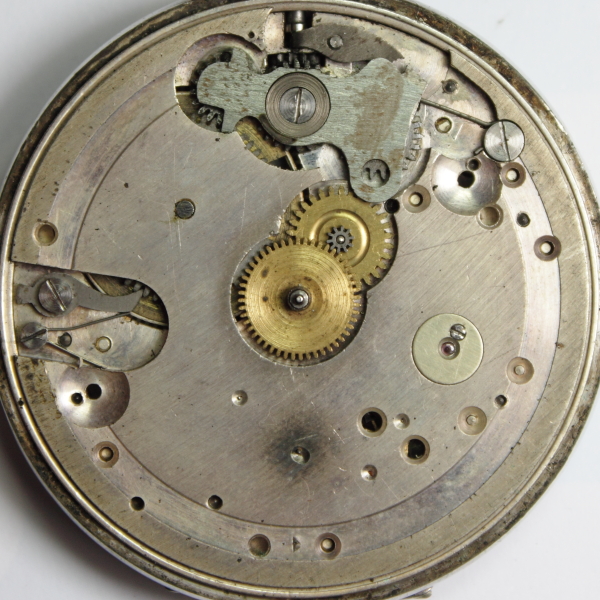
Interesting also is the layout of the dial side if we compare it to the M&ST cal 6 (cylinder escapement)
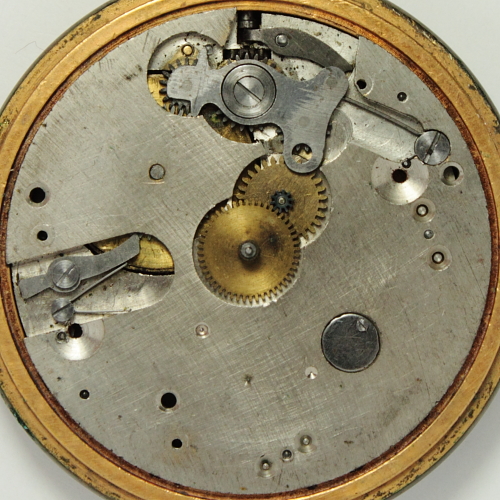
Now, I had always assumed that the MST cal 6 was an early calibre, but we already suspected that the calibres had been renumbered at some point (we only know this as the calibre 6 from the 1933 and later catalogues). In truth I don’t have one I can definitively date and I would assume all I have are post 1919. If this is in fact the case it appears that the 6 might be a redesign of an LTG calibre, or indeed an LTG cylinder calibre. I tend to ignore the 6′s that come up for sale but I guess I need to start looking for datable watches.
Coming back to my parts watch though, it seems to me that this calibre is indeed an LTG one and predates the merger. As such could it be the oldest Roamer watch? None of them have hallmarks, even though two are in Swiss silver cases. However the Marlboro has LTG markings and as such probably predates the merger. Which leaves two with Roamer dials. Before I consider these there is one other indicator of an older calibre and that is that the centre wheel on this calibre runs on a separate arbour to which the canon pinion is a friction fit. In more modern designs the centre wheel, like the other wheels, the arbour is fitted to the wheel. This indicates to me an older calibre design.
Another indicator I have noticed is that older calibres have on the dial side a cirular groove machined into the face.
Here is the Marlboro with groove

and here is the other Roamer without

To me this indicates that the Roamer is newer than the Marlboro, potentially putting the Roamer into M&ST production. Now the parts watch also has the groove but in addition it has a serial number. Now serial numbers tend to be found only from either smaller companies or those selling more expensive watches – it costs money to mark each one, and then of course since there is no point in marking without tracking that number, people have to spend time recording what happens to that watch. I have an M&ST watch with a groove and a serial number, which to me indicates that one predates all my other M&ST watches since I assume that M&ST abandoned the practice to save money – just as they stopped machining the groove (I have no idea of the purpose of the groove, but it must have one). The serial number to me indicates that the parts watch is older than the Marlboro and that would probably make it the oldest Roamer I own – but that will have to remain speculation until I manage to find an older one that is dated.
One other nice thing about the parts watch by the way is that the back of the dial has initials, a first for one of my collection.
Hi. I just acquired a l t g pocket watch. Saw this article and thought you could help me with info. Watch case says ltg switzerland and so does movement with1 jewel and 1 adjustment. I know nothing of watches so any info would be appreciated. Thanks scott
Hi Scott. If the case shows LTG then it’s likely to be a Meyer & Studeli watch rather than an L. Tieche Gammeter one. I’m going to guess that it’s a calibre 6.
Hi,
I am trying to find out about a tiny travel alarm clock which is marked Gammeter on the dial.
Any idea how old it is, and whether it is worth anything please?
Any information would be appreciated.
Thanks.
Angela.
Hi Angela,
Travel alarms tend not to have any special value unless they are made of precious metal, have a collectible name on the dial – like Tiffany or Cartier, or are a particularly collected design such as the sliding purse watches,
David
i have a early roamer 10 jewels , with a ceramic dial
That’s interesting. Do you have any further details?
i bought it and looking for parts, need a pallet and a setting lever , can i post pics on here i cant see any option
This version of the software doesn’t allow images. I might need to revise how the site is set up but that isn’t likely to happen in the near future.
OK , ITS A ROAMER CERAMIC DIAL . RED 12 THE RESYT OF THE NUMERALS BLACK
ROAMER PRINT ON DIAL IN RED , NO MARKING ON THE WATCH ITSELF ONLY 10 JEWELS PRINTED NEXT TO WINDING , AND SWISS MADE ON THE EDGE OF THE BASE PLATE ITS DEF A MST I75 HAVE LOOKED AT OTHER’S AS A TRENCH WATCH CONVERT FROM A POCKET WATCH , CASE BACK INSIDE SAYS KH &CO CASES NICKEL CHROME NUMBER 534562
M&ST had been making wristwatches since at least 1909 – I’m not sure I’ve seen any MST 175s as pocket watches – they appear only as wrist watches, so no ‘conversions.’ At that point M&ST were not making cases, so all were either cased at the factory using purchased cases, or cased in country of sale (eg UK and US). Case numbers are not meaningful as they tend to be casemaker numbers and not something applied by M&ST
Hi , I have recently bought a Gammeter Chrome Swiss alarm clock 15 Jewles ,it’s a small 2″x 2″ Square , inner face – it has a green Narrow border, an Inner old gold colour and in inner square is gold metal , with a Number 8 above a half circle , it’s encased in a Malayan Pewter Case and that acts as the stand for the clock , then the clock is packed away in the pewter Case , more like Arts and Crafts , fully Working it has a very silent tick ,and keeps excellent time , any information please . As to the dating of this time piece please .
Hard to comment without images. Roamer made a number of travel alarm, some in fancy cases. I’ve not seen a Gammeter, but I’ve not looked, but also Gammeter was a watchmaking family name so there are a couple of different companies who used the name. If it folds into the case and the case when flipped open is the stand then these were I would guess 1940’s to 1960’s.